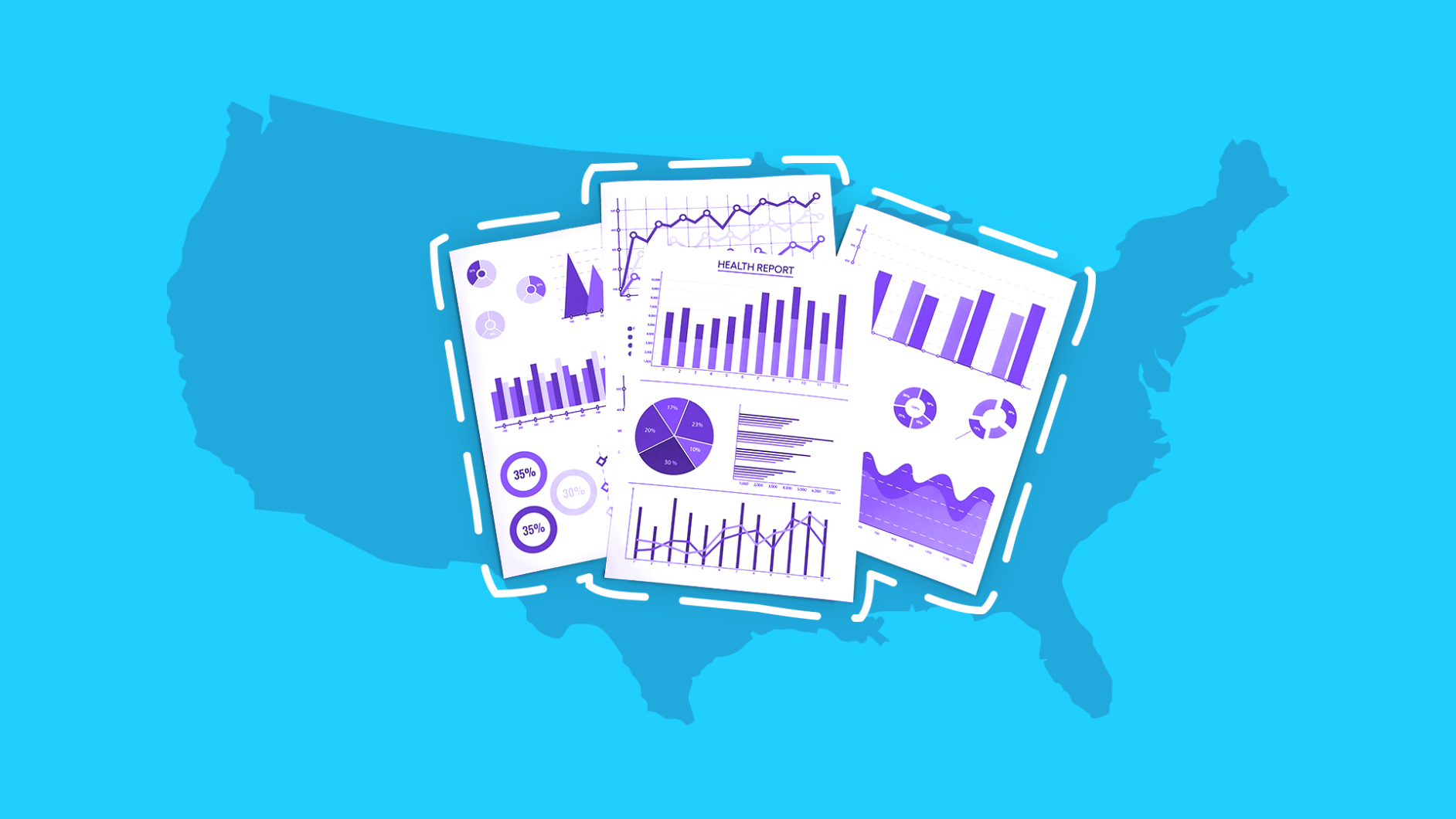What is autism? | How common is autism? | Autism statistics by age | Autism statistics by race and ethnicity | Intellectual disabilities | Co-occurring health conditions | Related costs | Epidemiology | Research
Children who find it difficult to hold a conversation, make eye contact, or empathize with others might fit somewhere on the autism spectrum. They may have compulsive behavior or repetitive movements. Although they may be captivated by a handful of things, they could be behind on their language or learning skills. Autism spectrum disorder (ASD) affects 1 in 54 children in the United States, and symptoms look a little different from person to person. There isn’t a cure for autism, and it’s a lifelong condition, but an early diagnosis can improve the quality of life of individuals with autism as well as their careers and relationships.
What is autism?
Autism is a developmental disorder that affects communication and behavior. It’s believed to be caused by environmental and genetic factors. Those with autism find social interactions difficult as well as have repetitive behaviors and focused interests. Autism is also a spectrum disorder, meaning the severity and range of symptoms are different from person to person.
Below are a few indicators of autism, according to the Diagnostic and Statistical Manual of Mental Disorders-V.
- No babbling or pointing by age 1
- No single words by age 16 months or two-word phrases by age 2
- Impaired ability to make friends with peers
- Impaired ability to initiate or sustain a conversation with others
- Repetitive or unusual use of language
- Abnormally intense or focused interest
- Preoccupation with particular objects or subjects
- Inflexible adherence to specific routines or rituals
“ASD can be thought of as something that impacts language and theory of mind,” says Merriam Saunders, LMFT, a psychotherapist based in California. “For some, the language impact means they are non-vocal or have limited language use. These are typically the [most severe] cases. Theory of mind is a fancy term for one’s ability to understand that what is in my head is not necessarily in your head, too. It is sometimes because of this difficulty that people with ASD have difficulty understanding [that] someone else might not want to talk about or hear at length about the thing they are most passionate about.”
Saunders also explains that other symptoms, such as sensory issues (difficulty with sounds, taste, touch, light), can range from severe to mild.
How common is autism?
- 1 in 160 children worldwide has an autism spectrum disorder. (Autism Research, 2012)
- About 1 in 54 U.S. children have an autism diagnosis. (Centers for Disease Control and Prevention, 2020)
- Autism was prevalent in nearly 2% of 8-year-old children in 2016. (Centers for Disease Control and Prevention, 2020)
- Autism was four times more prevalent among boys than among girls as of 2016 in the U.S. (Centers for Disease Control and Prevention, 2020)
Autism statistics by age
Today, autism diagnoses usually happen in early childhood, which may be why autism rates in children are higher than those in adults. However, because the definition of autism spectrum disorder has drastically evolved, many teens and adults could be living with undiagnosed ASD.
- Of those children with autism, 44% were evaluated by age 3. (Centers for Disease Control and Prevention, 2020)
- Children with a clinical diagnosis of autism has a median age of diagnosis of 4 years and 3 months. (Centers for Disease Control and Prevention, 2020)
- Prevalence estimates of autism in adults born between 1980 and 2012 are predicted to exceed 2.8% due to new diagnostic criteria. That’s about 3 out of every 100 adults in the U.S. in the future could carry a diagnosis based on this new criteria. (Open Minds, 2018)
Autism statistics by race and ethnicity
Minority groups are diagnosed with autism later and less often.
- The diagnosis of autism spectrum disorder is highest in non-Hispanic white children (18.5 per 1,000).
- Autism statistics are the lowest among Hispanic children (15.4 per 1,000).
- Autism prevalence rates in 8-year-olds increased by 10% between 2014 and 2016, and they increased by 175% between 2000 and 2016.
(Centers for Disease Control and Prevention, 2020)
Cognitive functioning among children with autism
Autism is not a learning disability, but it can affect cognitive function. Some children on the autism spectrum have delays in speech or learning, while others do not. Because it is a spectrum disorder, these delays can range from mild to severe.
- One-third of children with autism were classified as having an intellectual disability (IQ equal to or less than 70).
- 7% more girls than boys were identified to have an intellectual disability with autism (39% versus 32%).
- 24% of children with autism had an IQ in a borderline range (IQ 71-85).
- Black (47%) and Hispanic children (36%) were more likely than white children (27%) to have an intellectual disability with autism.
(Centers for Disease Control and Prevention, 2020)
Autism and co-occurring conditions
There is no cure or medication for autism spectrum disorder. Behavioral therapy is the most effective autism treatment. However, the vast majority (95%) of children with autism have at least one co-occurring condition, which is often treatable.
- More than half (53%) have autism and attention deficit hyperactivity disorder.
- More than half (51%) have autism and anxiety.
- A quarter (25%) have autism and depression.
- At least 60% of children with autism will have two comorbid conditions (e.g., sleep problems, seizures, intellectual disabilities, or gastrointestinal problems).
(Open Minds, 2018)
RELATED: Is your child being misdiagnosed with autism?
The cost of autism
Caregiving, therapy, and mediation for co-occurring conditions accrue a high cost for Americans with autism.
- Autism costs $60,000 per year on average through childhood due to special education services, healthcare costs, and parents’ lost wages.
- Costs increase in people with autism and intellectual disability.
- The mother is most often the primary caregiver for a child with autism. On average, mothers of children with ASD earn 35% less than mothers of children with other health conditions and 56% less than mothers of children with no disabilities or disorders.
- The cost of caring for people with autism is predicted to reach $461 billion by 2025 in the U.S.
(Autism Speaks, 2018)
RELATED: Medication management for people with disabilities
Is autism an epidemic?
Before discussing whether these numbers suggest an epidemic, it’s necessary to understand why autism statistics have increased. An epidemic is a spike in the rate of new cases. However, it’s unclear whether the prevalence of autism has really increased or if it’s just an increase in diagnoses.
Chris Abildgaard, LPC, a writer for Autism Parenting Magazine explains that there is an increase in identified cases of autism due to, “expanding the definition from autism to autism spectrum disorder (ASD); increasing knowledge of the disorder by professionals, which leads to an increase in better and earlier diagnoses; more consistency by CDC’s Autism and Developmental Disabilities Monitoring (ADDM) Network in the method used to identify cases; (and) an actual increase in the rate of children being born with the disorder.”
Autism research
- Prevalence of ASD among children aged 8 years, Centers for Disease Control and Prevention (CDC)
- Prevalence and trends of developmental disabilities among children in the United States, Pediatrics
- Diagnostic and Statistical Manual Of Mental Disorders, Fifth Edition, American Psychiatric Association
- Global prevalence of autism and other pervasive developmental disorders, Autism Research
- Adults with autism—a growing population and opportunity, Open Minds
- How to differentiate autism from a learning disability, ADDitude
- Autism: Epidemic or explosion? (And why it matters), Psychology Today
- Autism facts and statistics, Autism Speaks











